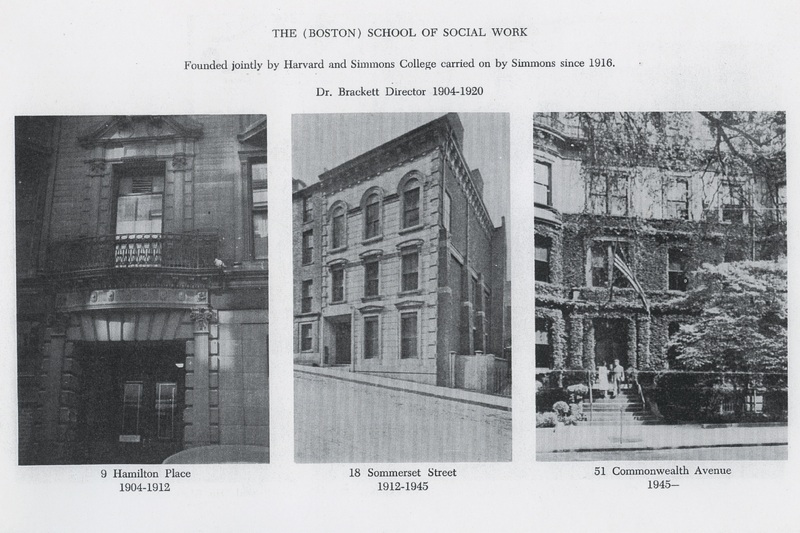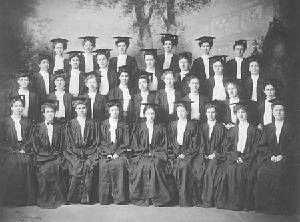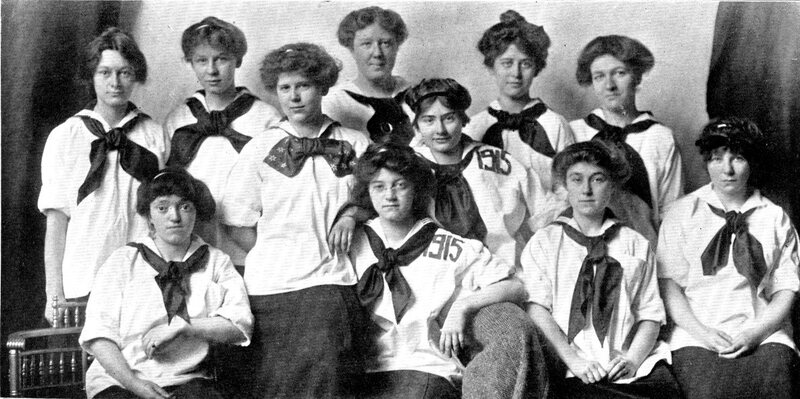The Early Years, 1904-1919

View of the three former homes of the School of Social Work: 9 Hamilton Place, 18 Somerset Street, and 51 Commonwealth Avenue, ca. 1945.
Simmons continued to develop its mission-based curriculum in 1904 with the creation of the Boston School for Social Workers. In collaboration with Harvard University, the program was the first academically-affiliated school of social work in the United States. Located at 9 Hamilton Place, the School initially offered a Bachelor of Science degree and added a Masters of Science degree in 1912. Jeffrey Richardson Brackett (1860-1949), a pioneer in the field of charity and social work, was appointed the School's first director. The program became an independent entity when Harvard withdrew from the partnership in 1916 and the Simmons College School of Social Work was born.
Simmons expanded program offerings to the realms of business and healthcare when the College joined with the Women's Educational and Industrial Union to offer Lucinda Prince's program for salesmanship. This program became the School of Salesmanship in 1915, and the School of Education for Store Service in 1918. It was later known as the Prince School of Retailing and became part of the School of Business Administration as the Prince School Program in Retailing in 1962. Students were also offered a program in physical therapy in 1917 and the School of Public Health Nursing was established in 1918.
The first dormitory, South Hall, and the dining hall, known as the Refectory, were built in 1905 on property purchased on Brookline Avenue, a five-minute walk from the Main College Building. North Hall was constructed in 1907, and small houses nearby were leased as the student body continued to grow. Later, the triangle bordered by Brookline Avenue, Pilgrim Road and Short Street, became known as the Simmons College Residence Campus, with a total of nine four-story brick dormitories. A one-story dining center, Bartol Hall, was added to the Refectory in 1953.
Simmons College held its first Commencement at nearby Jordan Hall in June 1906. Bachelor of Science degrees were conferred on thirty-two candidates, and certificates were awarded to more than one hundred students completing one-year programs. Immediately following the exercise, the newly graduated members of the Class of 1906 formed the Alumnae Association.
In 1912, the first Founder's Day Convocation (later Honors Convocation) was held for the entire College. The service was scheduled for the closest Wednesday to John Simmons's birthday, October 30.
As an institution focused on a practical education, Simmons created a community of students profoundly different from that of other women’s colleges in the early 20th century. Simmons students were largely from a middle-class background as opposed to the upper- and upper-middle class status of students at other women’s colleges. Simmons was also particularly attractive to Jewish students because the College was one of the few private institutions in the United States that did not impose a Jewish student quota.
The mission to train women for an independent livelihood extended beyond the economic and into the political realm, creating an activist ethos that manifested in the earliest members of the Simmons community. The first Dean of the College, Sarah Louise Arnold, served in prominent positions for multiple suffrage organizations and lectured publicly on the matter off campus. Students like Katherine Hobart (Class of 1916) also advocated publicly for the movement on and off campus while others like Wilda Claire Strong Peck (1911-1912 independent study student and later Instructor and Librarian at Simmons) became founding members of suffrage organizations like the Cambridge League for Women Voters. For more information about suffrage at Simmons, visit our exhibit Suffrage at Simmons.
Leadership skills and community bonds were further fostered in the student body through athletics. Outdoor sports were made possible in 1910 when the playing field behind the Main College Building was enclosed. Here, annual competitions, tennis tournaments, and later field hockey were held. The Student Athletic Association was also founded in 1910. Students played basketball indoors in the small west wing gymnasium of the Main College Building. As students from the Class of 1912 recorded in their yearbook, "[a]thletics are here to stay. Now that we have them firmly established, it is hard to believe that there was a time when we managed to exist without them."
Traditions, athletics, and events fostered a sense of belonging and helped students define what it meant to be a member of the Simmons community.

